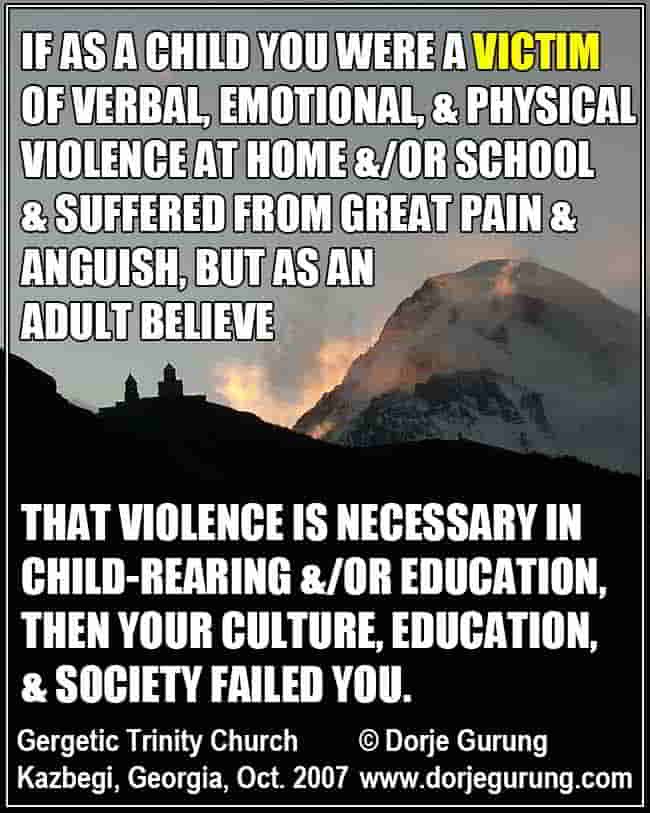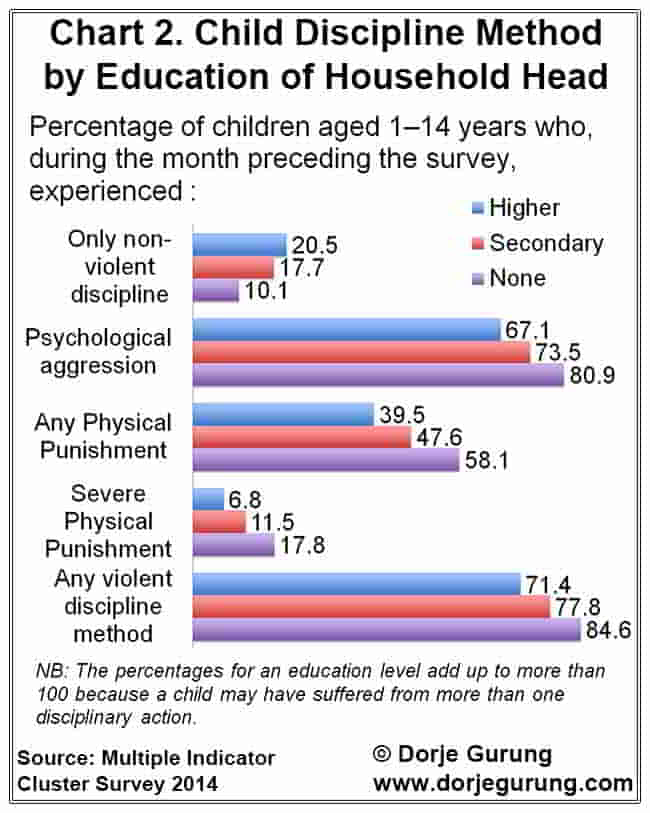If, as a child, you were a victim of verbal, emotional, and physical violence at home and/or school, and suffered from great pain and anguish, and even trauma, but as an adult you believe that violence is necessary in child-rearing and/or education, then your culture, education, and society have failed you.

Unfortunately, in Nepal we don’t have a death of such individuals.
Nepal did NOT make it into the list of the fifteen worst countries for a child to grow up in. However, using the prevalence of child-labor as evidence, The Diplomat asks if Nepal is one of the worst places for a child. Child-labor is, of course, but only one of the many issues with being a child in the country.
Violence against them — both at home and in school — is another one. Violence of all forms, perpetuated by care-givers — parents, teachers, administrators, and others — is highly prevalent. So prevalent as a matter of fact that they revised the law books in 2005 banning violence in school. In homes, however, it’s still not against the law.
One reason for the prevalence is traditional and cultural belief in their efficacy. According to Multiple Indicator Cluster Survey 2014 (MICS2014), about 35% of adults interviewed believed that physical punishments is necessary in child-rearing and education, for example (see image below). That’s 1 in 3 adults!!
No wonder, in general, about 78% and 82% of children aged 1-14 suffered from at least one form of “Psychological aggression” and a violent discipline method respectively the month preceding the interview. That’s pretty much 4 out of 5 children, which, to me, is worryingly high.
If there is any consolation, it’s that the level of severe physical punishment stands at lowly 14%. However, with 35% believing in physical punishments, to me that appears to be a little bit off! What of the percentage of children disciplined exclusively non-violently? Just 13%.
Interestingly, there’s SOME difference in discipline method employed based on the wealth of the family as you can see from the image below.
The level of “psychological aggression” and “any violent discipline method” employed by the richest quintile (the top 20%), while lower than the national average, aren’t dramatically lower however. In other words, they are still worrying high! Wealth does NOT make you a significantly “better” adult as far as the children are concerned when it comes to violence against them!
Given the variation in culture between populations in different ecological zones in the country, I expected differences in the discipline methods between them. Not surprisingly, there are some differences (see image below).
Another assumption I had was that education level would make a big difference. Of course, we do have an issue with the level of education of the population being really low. We don’t even have 100% literacy as yet.
Those with more than secondary school education (see image below) represent less than 15% (less than 1 in 7) of the population.

Regardless, the chart below shows the breakdown by level of education. 67% of children living in households headed by someone with more than secondary school education (“Higher” in the image) experienced at least one psychological aggression. As for a violent discipline method, 71% were subjected to it.
While they are each about 10% lower than the national average, the percentages on their own are again worryingly high! What is kind of reassuring is that the rate at which children in households headed by someone with a higher level of education were twice as likely (21%) to be disciplined non-violently than those in households headed by someone with no education (10%). So, education does lead to adults employing a higher rate of non-violent discipline methods.
To conclude, violence against children, based on the MICS2014 data, is worryingly high.
Violence in schools and homes was routine when I was young. Therefore, I wouldn’t be surprised if a VAST majority of adult MICS2014 interviewees were likely victims themselves as children. Not surprisingly, our culture, our education, and our society continue to normalize violence against children. In doing so, they have failed us!
“So, our culture, education, and society may have failed us,” you might argue, and throw your hands up in the air and say, “It’s NOT our fault that we are violent against our children! Our culture, education, society, and people taught us to be so AND expect us to be so.”
Yes there is some logic to that. Our culture, education, and society have failed us. But we don’t have to fail our children, something us Nepalis adults are guilty of. (I am sure it was in recognition of that that the country passed laws in 2005 against violence against children in schools.)
We, as individuals, have a choice! We have a choice in whether we follow the dictates and expectations of our culture, education, society and people. We can choose not to, as tough as that might be, and in the process SHAPE our society. In other words, as much as we are products of our culture, education, society, and people, we are also shapers of our culture, education, society, and people.
Whether we endorse violence against children and mete them out, for example, is in our hands. We can choose to NOT perpetuate it, and thus contribute to the transformation of our mentality and therefore our culture and society.
Studies have demonstrated beyond doubt that violence during childhood can induce trauma which changes the brain and can have lasting effect on the person, some leading to mental health issues as adults. (See references below for additional resources on that.) The last estimate I saw for the rate of mental health disorders in the population in Nepal was 37.5%. What percentage of those resulted from childhood trauma? We don’t know because there have been no studies and/or we have no data. But, likely a significant percentage. That needs to change.
And how do we change that?
What is lacking, if it has not already been clear, is education, and more specifically, education on empathy and compassion. Somehow, while we take pride in the country being the birthplace of the man who championed and introduced to the world non-violence and compassion (and denounced the caste system), we completely ignore his teachings, sadly! All we need to do is to just follow his teachings.
Make empathy and compassion part of the formal and informal education system. There are many ways of doing that though I should add that they are NOT without their challenges. Where discrimination, and therefore even ill-treatment of fellow citizens based on the archaic beliefs informed by the caste system, is part of the DNA of the society, yes, teaching empathy and compassion will be challenging. But there are ways, such as reading and instilling a reading habit in the children, for example. Another is raising and educating children with pets or by using the domesticated animals, to give but just one other example.
And, finally and most importantly, as adults, display empathy and compassion for children by treating them in just the way you would liked to have been treated when you yourself were a young child.
What do you think?
References
The Independent Center (March 2018). How Trauma Changes the Brain.
Cleveland Clinic (April 2020). Childhood Trauma’s Lasting Effects on Mental and Physical Health. How to help children recover and thrive after adversity
Psychlopaedia (Jan. 2018). How childhood trauma changes our mental health into adulthood. How you cope with stress is influenced by your earlier experiences, your genes and brain regulation.
PubMed.gov (2009). A longitudinal study of the effects of childhood trauma on symptoms and functioning of people with severe mental health problems. This study examines the relationship between childhood trauma and the psychiatric symptoms and psychosocial functioning of adults with severe mental health problems.
Psychology Today (Oct. 2019). Three Ways Childhood Trauma Affects Adulthood. Complex childhood trauma is subtle but has long-term consequences.





